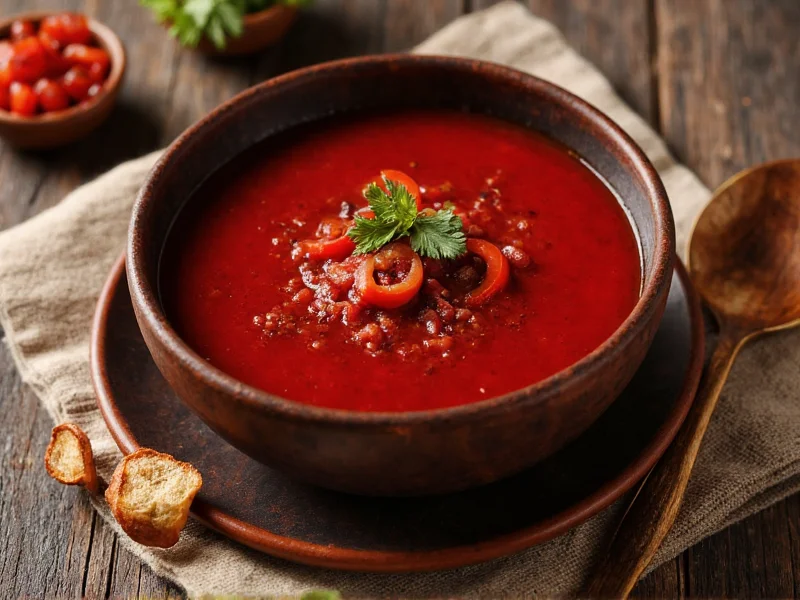Understanding Blood Soup Across Cultures
Blood soup represents one of humanity's oldest culinary traditions, dating back to when our ancestors utilized every part of hunted animals. This practice wasn't merely practical but reflected deep respect for food resources. Today, blood soup continues as a cherished element in many cultural cuisines worldwide, each with distinctive preparation methods and flavor profiles.
Global Varieties of Blood Soup
From Nordic regions to Southeast Asia, blood soup appears in remarkably diverse forms. Each culture has developed unique approaches to incorporating blood into nourishing broths that satisfy both nutritional needs and culinary preferences.
| Dish Name | Region | Key Ingredients | Distinctive Characteristics |
|---|---|---|---|
| Svartsoppa | Sweden | Duck or goose blood, meat, apples, port wine | Served before Christmas dinner, often with boiled potatoes |
| Tiết Canh | Vietnam | Duck or pig blood, fish sauce, herbs | Served warm with rice noodles, considered a breakfast dish |
| Długie | Poland | Pig blood, barley, meat | Traditional Christmas Eve soup, often with mushrooms |
| Soondae-guk | Korea | Pig blood sausage, broth, vegetables | Served with rice, often after drinking alcohol |
| Härngrätt | Iceland | Lamb blood, rye flour, onions | Part of traditional þorramánaður midwinter festival |
Preparation Techniques and Food Safety
Traditional blood soup preparation requires specific techniques to ensure both safety and proper texture. Fresh blood must be collected with anticoagulants like vinegar or salt to prevent premature clotting. Many cultures use rice wine, vinegar, or citrus to stabilize the blood during cooking.
Modern food safety standards require blood to be sourced from inspected facilities and processed quickly. When preparing blood soup at home, cooks should use blood within 24 hours of collection and maintain proper cooking temperatures to eliminate potential pathogens. The blood typically thickens when heated, creating the soup's distinctive texture without additional thickeners.
Nutritional Profile and Health Considerations
Blood soup offers notable nutritional benefits that explain its historical importance in many diets. Animal blood is rich in:
- High-quality protein (approximately 13g per cup)
- Iron (providing up to 40% of daily needs per serving)
- Zinc and vitamin B12
- Essential amino acids
These nutritional attributes made blood soup particularly valuable in traditional societies where iron deficiency anemia was common. However, individuals with hemochromatosis or other iron metabolism disorders should consume blood soup in moderation. The dish generally contains minimal fat when prepared traditionally, making it a relatively lean protein source compared to many meat-based soups.
Cultural Significance and Modern Adaptations
Blood soup carries deep cultural meaning beyond mere sustenance. In many societies, it represents respect for the animal and rejection of waste. Scandinavian blood soup traditions connect to pre-Christian harvest celebrations, while Asian varieties often appear in ceremonial contexts.
Contemporary chefs have begun reinterpreting traditional blood soup recipes, focusing on refined presentations while maintaining authentic flavors. Some restaurants now feature blood soup on seasonal menus, introducing this ancient food to new audiences. Food preservation movements have also renewed interest in blood-based dishes as examples of sustainable "nose-to-tail" eating practices.
Preparing Blood Soup at Home
For those interested in traditional blood soup preparation, here are essential guidelines:
- Source fresh, food-grade blood from reputable butchers or specialty markets
- Use acidic ingredients like vinegar or citrus to prevent premature clotting
- Maintain broth temperature below boiling when adding blood
- Stir gently in one direction to create smooth texture
- Consume immediately as blood soup doesn't store well
Traditional Swedish svartsoppa preparation demonstrates these principles well. The recipe begins with a rich duck broth, into which a mixture of duck blood, port wine, and cream is gradually incorporated while carefully controlling temperature. The soup finishes with diced apples and served with boiled potatoes.
Frequently Asked Questions
Is blood soup safe to eat when prepared traditionally?
Yes, blood soup is safe when prepared following traditional methods with fresh, properly handled blood. The cooking process eliminates potential pathogens, and the acidic ingredients used in most recipes create an environment unfavorable to bacterial growth. Commercially prepared blood products from inspected facilities meet strict food safety standards.
Why do different cultures have blood soup traditions?
Blood soup traditions developed independently across cultures as practical food preservation methods. Before refrigeration, using blood immediately after slaughter prevented waste and provided valuable nutrition. These traditions persisted because they created distinctive flavors and textures that became culturally significant over generations.
What gives blood soup its distinctive texture?
The unique texture comes from the coagulation of proteins in the blood when heated. Traditional recipes control this process by gradually incorporating blood into warm (not boiling) broth while stirring constantly. The addition of acidic ingredients like vinegar or citrus helps regulate the coagulation, creating a smooth, velvety consistency rather than chunks.
Can vegetarians find acceptable alternatives to blood soup?
While no vegetarian alternative perfectly replicates blood soup's unique properties, some chefs create mushroom-based broths that mimic the earthy flavor profile. Beetroot and red lentils can provide similar color, while nutritional yeast adds umami depth. These alternatives capture some sensory elements but differ significantly in nutritional composition.
How has blood soup evolved in modern cuisine?
Contemporary chefs approach blood soup with both respect for tradition and modern culinary techniques. Some refine traditional recipes with premium ingredients, while others incorporate blood into innovative dishes like blood-infused sauces or desserts. The growing nose-to-tail eating movement has renewed appreciation for blood as a sustainable ingredient, though preparation methods now follow stricter food safety protocols than historical practices.











 浙公网安备
33010002000092号
浙公网安备
33010002000092号 浙B2-20120091-4
浙B2-20120091-4